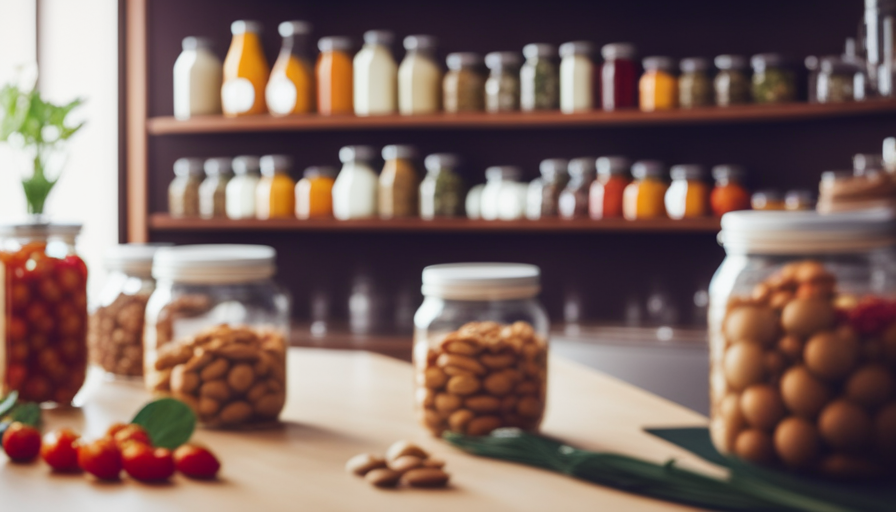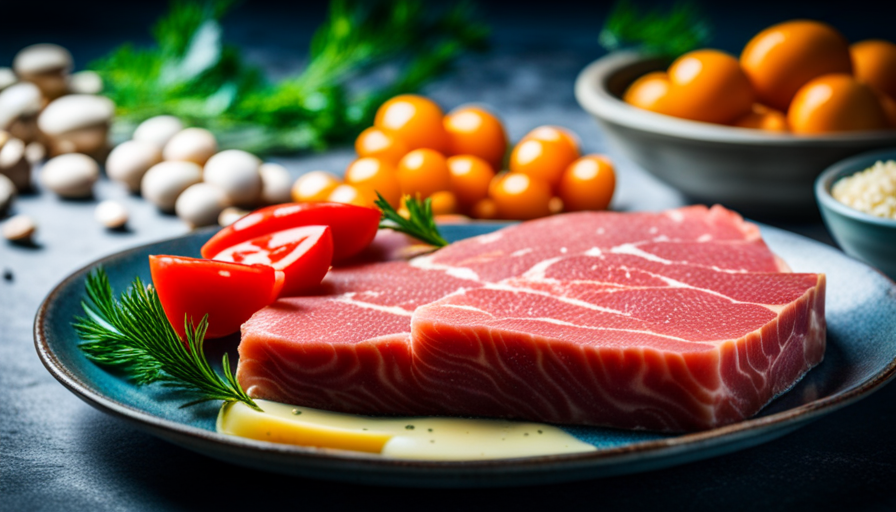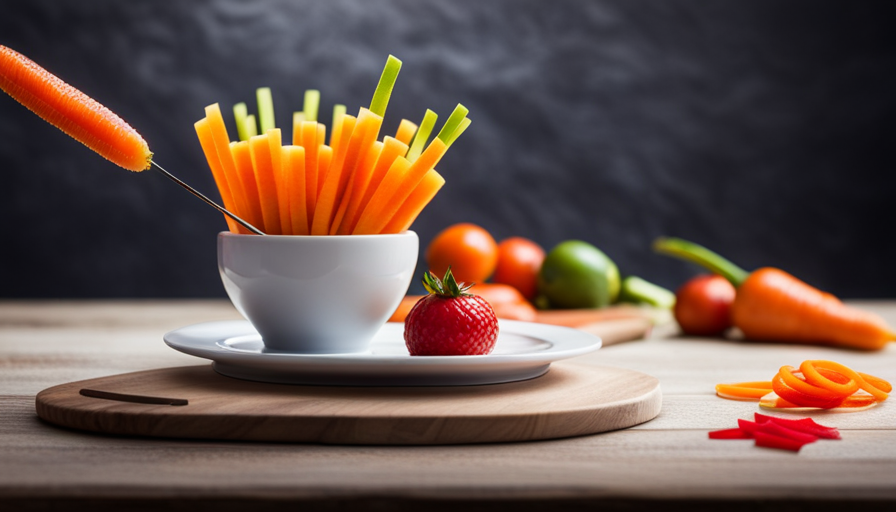Have you ever pondered why certain raw foods spoil rapidly while others stay fresh for an extended time? The key lies in the correct storage methods. Grasping the principles of food preservation and applying effective strategies can help you keep your raw foods fresh and safe for consumption.
In this article, we will explore the importance of maintaining proper food storage temperatures and organizing your refrigerator for optimal storage. We will delve into the specific techniques for storing raw meat and poultry, preserving fresh fruits and vegetables, and ensuring the longevity of dairy products, grains, legumes, and nuts. Additionally, we will discuss the best practices for storing herbs and spices and utilizing freezing techniques for long-term storage.
Furthermore, we will address the crucial topic of preventing cross-contamination in your kitchen, to ensure the safety of your stored raw food. By following these guidelines, you can extend the shelf life of your raw food and maintain its quality, ultimately saving you money and reducing food waste.
Key Takeaways
- Proper storage techniques are crucial for maintaining the freshness and safety of raw food.
- Perishable items like meat, poultry, and seafood should be stored below 40 degrees Fahrenheit (4 degrees Celsius) to slow down bacterial growth.
- Good food handling techniques can prevent cross-contamination, such as washing hands, using separate cutting boards, and storing raw food in sealed containers.
- Organizing the refrigerator is important for optimal storage, with different temperature zones for different types of food.
Understanding Proper Food Storage Temperatures
Did you know that storing raw food at the correct temperatures is crucial for ensuring its freshness and safety? Proper food handling and preventing food spoilage are essential aspects of storing raw food. Understanding the proper food storage temperatures can help you maintain the quality and safety of your food.
When it comes to storing raw food, it’s important to keep perishable items, such as meat, poultry, and seafood, at temperatures below 40 degrees Fahrenheit (4 degrees Celsius). This is because cold temperatures slow down the growth of bacteria, which can cause foodborne illnesses. Make sure to place these items in the refrigerator as soon as you bring them home from the store.
On the other hand, non-perishable items, like canned goods and dry goods, can be stored at room temperature. However, it’s still important to keep them in a cool, dry place away from direct sunlight and heat sources. This will help prevent spoilage and maintain their quality for a longer period.
In addition to proper temperature, it’s also crucial to practice good food handling techniques. This includes washing your hands thoroughly before and after handling raw food, using separate cutting boards for raw meat and vegetables, and storing raw food in sealed containers to prevent cross-contamination.
By understanding and implementing the proper food storage temperatures and handling techniques, you can ensure the freshness and safety of your raw food, preventing food spoilage and potential health risks.
Organizing Your Refrigerator for Optimal Storage
Arrange your fridge like a well-orchestrated symphony, with meat tucked away in the chilly depths, crisp vegetables dancing on the top shelf, and delicate fruits perched like jewels in the crisper drawer. Optimal refrigerator organization is key to preventing food spoilage and ensuring that your raw food stays fresh for as long as possible.
Here are three essential tips to keep in mind:
-
Categorize: Group similar items together to create order and make it easier to find what you need. Keep raw meats separate from other foods to prevent cross-contamination. Place them in sealed containers or on plates to catch any potential drips. Vegetables and fruits can be stored in breathable bags or containers to maintain their freshness and prevent them from wilting or becoming mushy.
-
Temperature Zones: Different parts of your refrigerator have different temperature zones, and it’s important to utilize them correctly. The colder back and bottom areas are perfect for storing meats and dairy products, while the top shelf is ideal for delicate items like herbs and cooked leftovers. The crisper drawer provides a controlled humidity environment for fruits and vegetables, so make sure to adjust the humidity setting accordingly.
-
First In, First Out: To minimize food waste, adopt the ‘first in, first out’ rule. Place newer items behind older ones to ensure that you use up the older products first. This simple practice helps prevent forgotten leftovers from spoiling and saves you money in the long run.
By following these optimal refrigerator organization techniques and preventing food spoilage, you can extend the shelf life of your raw food and enjoy fresh, delicious meals every time.
Storing Raw Meat and Poultry
Tuck away meat and poultry in the chilly depths of your refrigerator, ensuring they stay fresh and ready for your next culinary masterpiece. When it comes to storing raw meat and poultry, it’s important to follow proper guidelines to maintain their quality and prevent any potential foodborne illnesses.
Firstly, it’s crucial to keep raw meat and poultry separate from other foods to avoid cross-contamination. Place them in sealed containers or zip-top bags to prevent any juices from leaking onto other items.
Additionally, storing raw fish requires special attention. It’s best to keep it in the coldest part of the refrigerator, such as the bottom shelf or the meat drawer, to maintain its freshness.
Marinating techniques for poultry are a popular way to enhance its flavor. If you plan to marinate poultry, it’s essential to do it in the refrigerator. Place the poultry and the marinade in a sealed bag or container and let it sit for the recommended time, usually a few hours or overnight. Remember to discard any leftover marinade that has come into contact with raw poultry to avoid any potential contamination.
By following these guidelines, you can ensure that your raw meat and poultry stay fresh and safe for consumption. Proper storage and handling are key to maintaining the quality and taste of your ingredients, so take the time to organize your refrigerator and follow the recommended techniques.
Preserving Fresh Fruits and Vegetables
To keep your fresh fruits and vegetables at their peak, make sure to properly clean and prepare them before placing them in your refrigerator. This will help to remove any dirt, bacteria, or pesticides that may be present on the surface.
Once cleaned, you can take steps to preserve your produce and extend its shelf life. One way to preserve fruits and vegetables is by canning them. Canning involves placing the produce in jars and sealing them to create an airtight environment. This helps to prevent the growth of bacteria and other microorganisms that can cause food spoilage. Canned fruits and vegetables can last for months or even years if stored properly.
Another method of preserving fresh produce is by drying them. Drying removes the moisture from the fruits and vegetables, inhibiting the growth of bacteria and mold. You can dry fruits and vegetables using a dehydrator, an oven, or even by air-drying them. Once dried, they can be stored in airtight containers and will remain edible for several months.
Preserving fresh fruits and vegetables is a great way to enjoy them throughout the year. By canning or drying them, you can ensure that your produce stays fresh and flavorful for an extended period of time. So, next time you have an abundance of fruits and vegetables, consider preserving them to enjoy their goodness all year round.
Tips for Storing Dairy Products
When it comes to keeping dairy products fresh, you’ll want to make sure you properly store them to maintain their flavor and texture. Dairy products have a limited shelf life, and it’s important to pay attention to their expiration dates. To help you store your dairy products effectively, here are some tips:
-
Use the right storage containers: It’s essential to choose the best storage containers for dairy products. Opt for airtight containers to prevent air and moisture from entering, which can lead to spoilage. Glass or plastic containers with tight-fitting lids are ideal options.
-
Keep dairy products refrigerated: Dairy products should always be stored in the refrigerator at temperatures between 34°F and 40°F (1°C and 4°C). This helps slow down bacterial growth and extends their shelf life.
-
Follow expiration dates: Dairy products have specific expiration dates that should not be ignored. Always check the labels and consume them before they expire to ensure freshness and safety.
Table:
| Dairy Product | Expiration Date | Best Storage Container |
|---|---|---|
| Milk | 5-7 days | Airtight plastic bottle |
| Yogurt | 1-2 weeks | Glass or plastic container with lid |
| Cheese | Varies (check label) | Cheese paper or airtight container |
By following these tips and paying attention to expiration dates, you can ensure that your dairy products stay fresh for as long as possible. Proper storage will help maintain their flavor and texture, so you can enjoy them to the fullest.
Keeping Seafood Fresh and Safe to Eat
Keep your seafood fresh and safe to eat by following these essential tips. Safe handling and preventing spoilage are key when it comes to seafood.
To start, always purchase seafood from a reputable source. Look for fresh fish with clear eyes, shiny skin, and a mild ocean smell.
Once you bring your seafood home, it’s important to store it properly to maintain its freshness. Keep seafood refrigerated at a temperature below 40°F (4°C). Wrap it tightly in plastic wrap or place it in a sealed container to prevent any cross-contamination with other foods. It’s also crucial to consume seafood within two days of purchase to ensure its safety.
When handling seafood, remember to follow basic food safety practices. Wash your hands thoroughly with soap and water before and after handling raw seafood. Use separate cutting boards and utensils for seafood to avoid cross-contamination. When cooking seafood, make sure it reaches the appropriate internal temperature to kill any bacteria. For fin fish, the internal temperature should reach 145°F (63°C), while shellfish should reach 165°F (74°C).
Preventing spoilage is equally important. If you’re not planning to cook your seafood immediately, freeze it to maintain its freshness. Wrap it tightly in plastic wrap or place it in freezer-safe bags, making sure to remove any excess air. Label your seafood with the date of freezing to keep track of its storage time. When thawing frozen seafood, do so in the refrigerator or under cold running water. Avoid thawing seafood at room temperature, as this can promote bacterial growth.
By following these safe handling and spoilage prevention tips, you can ensure that your seafood stays fresh and safe to eat. Enjoy your delicious seafood dishes with peace of mind!
Storing Grains, Legumes, and Nuts
Make sure you’re storing grains, legumes, and nuts properly to maintain their freshness and flavor. Proper storage techniques are essential to prevent spoilage and preserve the nutritional value of these food items.
When it comes to storing grains, it’s important to keep them in a cool, dry place, preferably in airtight containers. This helps protect them from moisture and pests. Avoid storing them in the refrigerator, as the fluctuating temperatures can cause them to spoil faster. Additionally, it’s recommended to store grains away from strong-smelling foods, as they can absorb odors easily.
For legumes, it’s best to store them in airtight containers as well, in a cool, dark place. This helps maintain their quality and prevent them from becoming stale. It’s important to note that legumes have a shorter shelf life compared to grains, so it’s advisable to consume them within a reasonable time frame.
When it comes to nuts, it’s crucial to keep them in airtight containers, away from heat and light. This helps preserve their freshness and prevent them from becoming rancid. It’s also recommended to store nuts in the refrigerator or freezer, especially if you live in a warm climate.
By following these storage techniques, you can ensure that your grains, legumes, and nuts remain fresh and flavorful for a longer period of time.
Properly Storing Herbs and Spices
To maintain the vibrant flavors and aromas of your herbs and spices, you’ll want to ensure they’re stored properly. Here are some techniques that will help you keep them fresh for a longer period:
-
Choose the right containers: Store your herbs and spices in airtight containers to prevent moisture and air from seeping in. Glass jars with tight-fitting lids are ideal for this.
-
Keep them away from light: Light can cause herbs and spices to lose their potency. Store them in a dark cupboard or drawer to protect them from exposure to sunlight.
-
Store them in a cool and dry place: Heat and humidity can cause herbs and spices to degrade quickly. Keep them in a cool and dry location, away from the stove or any other source of heat.
-
Label and date your containers: It’s important to know when you purchased or harvested your herbs and spices. Label each container with the name of the herb or spice and the date of purchase or harvest.
-
Avoid storing them near strong-smelling items: Herbs and spices can easily absorb odors from other strong-smelling foods. Keep them away from garlic, onions, and other pungent ingredients.
By following these storage techniques, you can ensure that your herbs and spices stay fresh and flavorful for a longer period, enhancing the taste of your dishes.
Freezing Techniques for Long-Term Storage
Now that you’ve learned how to properly store your herbs and spices, let’s dive into the freezing techniques for long-term storage of raw food. Freezing is a fantastic method to preserve the freshness and flavor of your food, and it’s surprisingly easy to do.
One effective technique for freezing raw food is vacuum sealing. This method involves removing all the air from the packaging before sealing it, which helps to prevent freezer burn and maintain the quality of the food. Vacuum sealing is particularly useful for items like meats, fruits, and vegetables, as it helps to lock in their natural flavors and nutrients.
Another popular method for long-term storage is canning. This involves placing the raw food in a jar and sealing it with either a pressure canner or a water bath canner. The high heat used in the canning process kills any bacteria, ensuring that the food remains safe to eat for an extended period.
Whether you choose to vacuum seal or use canning methods, both techniques are excellent options for storing raw food for an extended period. By following these methods, you can preserve the taste, texture, and nutritional value of your raw food, allowing you to enjoy it months later as if it were just freshly harvested.
Preventing Cross-Contamination in Your Kitchen
To prevent cross-contamination in your kitchen, ensure that you separate and sanitize cutting boards, utensils, and countertops when preparing different types of ingredients. This is crucial for maintaining kitchen hygiene and preventing the spread of harmful bacteria. By using separate cutting boards for raw meats, fruits and vegetables, and cooked foods, you can minimize the risk of cross-contamination. It is also important to sanitize these surfaces after each use to kill any bacteria that may be present.
In addition to separating and sanitizing, practicing good kitchen hygiene is essential. Wash your hands thoroughly with soap and warm water before and after handling different ingredients. This will help eliminate any potential bacteria that may be on your hands. Also, be mindful of how you handle utensils and other kitchen tools. Avoid using the same utensils for raw and cooked foods, and make sure to wash them in hot soapy water or run them through the dishwasher after each use.
To further emphasize the importance of preventing cross-contamination and maintaining kitchen hygiene, here is an emotional response evoking table:
| Contaminated Kitchen | Clean Kitchen | Safe Kitchen |
|---|---|---|
| Illness | Freshness | Health |
| Danger | Purity | Well-being |
| Dirty | Hygiene | Safety |
By following these guidelines and incorporating proper hygiene practices into your cooking routine, you can ensure that your kitchen remains a safe and healthy environment for food preparation.
Frequently Asked Questions
How long can raw meat and poultry be stored in the refrigerator?
To ensure safe consumption, raw meat and poultry should be stored in the refrigerator for a limited period. Follow these storage tips and proper handling procedures. Keep raw meat and poultry in the fridge for no longer than 2 days to maintain freshness and reduce the risk of bacterial growth.
Always store them in airtight containers or sealed plastic bags to prevent cross-contamination with other foods.
Can fresh fruits and vegetables be stored together in the same container?
Did you know that the average American wastes about 30% of their fresh fruits and vegetables each year? To ensure that your produce stays fresh for longer, it’s important to store them properly.
While it may seem convenient to store fresh fruits and vegetables together in the same container, it can actually have a negative impact on their shelf life. This is because certain fruits produce ethylene gas, which can cause other produce to ripen and spoil faster.
It’s best to store them separately to maintain their freshness.
What is the best way to store dairy products to extend their shelf life?
To extend the shelf life of dairy products, it’s important to use the best storage methods. Start by keeping them in the refrigerator at a temperature below 40°F.
Store milk, yogurt, and cheese in their original containers, tightly sealed to prevent moisture and odors from entering. Avoid storing dairy products on the refrigerator door, as temperature fluctuations can occur.
Additionally, common mistakes include leaving dairy products out at room temperature for too long and not checking expiration dates regularly.
Can seafood be stored in the freezer for an extended period of time?
Freezing seafood is an excellent way to extend its shelf life, but it can affect the taste and texture if not done properly. To maintain the quality, make sure to package the seafood in airtight containers or freezer bags to prevent freezer burn.
When thawing, it’s best to do it slowly in the refrigerator overnight. This ensures that the seafood maintains its moisture and flavor. Avoid thawing at room temperature, as it can lead to bacterial growth.
How can I prevent cross-contamination when storing different types of food in my kitchen?
To prevent cross-contamination in the kitchen and ensure food safety, it’s crucial to store different types of food properly.
When it comes to raw meat and poultry, always keep them separate from other foods in the refrigerator. Place them on the bottom shelf to prevent any drips or juices from contaminating other items. Additionally, store them in leak-proof containers or sealed plastic bags to minimize potential contamination.
Regularly clean and sanitize the refrigerator to maintain hygiene and prevent the spread of harmful bacteria.
What is the best way to store raw animal foods to prevent cross-contamination during preparation?
The best way for food handlers to prevent crosscontamination control when storing raw animal foods is to store them separately from cooked items. Use different cutting boards and utensils for raw meats to avoid bacterial transfer. Keep raw meats in sealed containers on the bottom shelf of the refrigerator to prevent drips onto other foods.
Conclusion
Congratulations! You’ve now mastered the art of storing raw food like a pro. By understanding proper food storage temperatures and organizing your refrigerator strategically, you can ensure your ingredients stay fresh and delicious.
Whether it’s storing raw meat and poultry, preserving fresh fruits and vegetables, or even properly storing herbs and spices, you’re well-equipped to handle it all.
Don’t forget the freezing techniques for long-term storage and the importance of preventing cross-contamination in your kitchen.
Now go forth and create culinary masterpieces with confidence!









